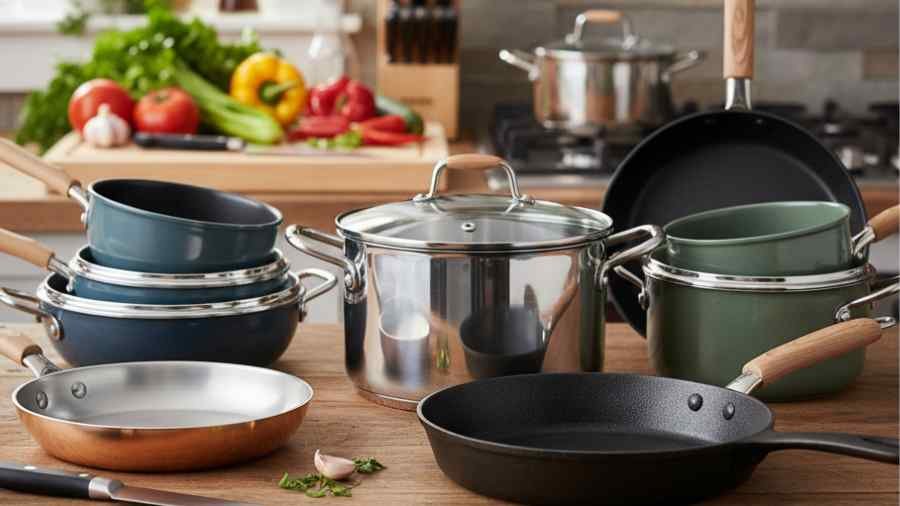The Best Cookware Materials Explained

From understanding what “nonstick” really means to choosing the best cookware material for health, this guide breaks down everything you need to know before buying a new cookware set.
Cooking at home isn’t just about taste, it’s about safety and health too. When cooking at home, safety and health are just as important as flavour. You may achieve the best results in your kitchen without exposing yourself or your family to harmful pollutants by choosing the healthiest cookware material.Let’s explore the many types of cookware and their unique characteristics.
Top Rated Cookware Materials
Stainless Steel: Durable and Healthy
Stainless steel is one of the most popular cookware materials and a reliable choice for most home cooks. High-quality stainless steel cookware is safe, durable, and ideal for high-heat cooking.
Pros: Oven- and grill-safe, long-lasting, easy to clean
Cons: Poor heat conduction on its own, can be pricey
Best for: People looking for a safe cookware material that lasts, can handle high heat, and doesn’t react with food
Aluminum: Lightweight and Affordable
Aluminum is good heat conductor and is commonly used as the base in many cookware sets, including nonstick and ceramic-coated pans.
Pros: Affordable, lightweight, heats evenly
Cons: Not compatible with induction cooktops, can wear over time
Best for: People seeking a best cookware material for everyday use that’s light and quick to heat
Copper: Responsive and Precise
Copper is a gorgeous, highly conductive metal that reacts quickly to temperature changes, giving you precise control while cooking.
Pros: Heats and cools rapidly, nonstick properties develop over time
Cons: Requires more maintenance, expensive, not induction-ready
Best for: Many experienced bakers looking for the best cookware to ensure precise cooking
Cast Iron: Heat Retention Champion
Cast iron is heavy but excellent at holding and distributing heat. It’s perfect for searing meats, slow-cooking, and even baking.
Pros: Retains heat well, versatile, durable
Cons: Heavy, requires seasoning to prevent rust
Best for: Those who want most healthy cookware material for high-temperature cooking and long-term durability
Enameled Cast Iron: Easier to Maintain
Enameled cast iron combines all the benefits of traditional cast iron with a smooth enamel coating for easy cleaning and no seasoning.
Pros: High heat tolerance, easy cleanup, versatile
Cons: Heavy, can chip, expensive
Best for: People seeking a non toxic cookware material that performs well without maintenance
Carbon Steel: Lighter Alternative to Cast Iron
Carbon steel behaves similarly to cast iron but is lighter and quicker to heat. It’s ideal for stir-frying, searing, and restaurant-style cooking.
Pros: Lightweight, heats fast, versatile
Cons: Needs seasoning, can rust if neglected
Best for: Cooks who want a healthy material for cookware with easier handling than cast iron
Nonstick
Nonstick pans, typically built on aluminum or stainless steel bases, prevent food from sticking. The Alva Maestro nonstick frying pan provides effortless food release and easy cleanup, making it ideal for everyday cooking.
Pros: Easy to clean, requires less oil
Cons: Not suitable for high heat, coating wears over time
Best for: People who are new to cooking or who want the best nonstick cookware for eggs, pancakes, or other delicate dishes
Ceramic: Teflon-Free Nonstick
Without the use of conventional Teflon coatings, ceramic cookware has nonstick and nontoxic qualities. Aluminium or stainless steel bases with a ceramic finish are frequently used in contemporary ceramic pans.
Pros: Lightweight, Teflon-free, easy to clean
Cons: Nonstick fades faster, can burn food if overheated
Best for: Anyone looking for the safest cookware material without sacrificing functionality
Choosing the Best Cookware Material
It’s crucial to take your culinary tastes, stove type, and cooking method into account when choosing cookware. Depending on how and what you cook, different cookware materials provide special advantages. For durability and health
Stainless steel and cast iron are long-lasting, non-reactive, and excellent for high-heat cooking, making them some of the healthiest cookware materials.
For ease of use
Nonstick pans, including options like the Alva Maestro nonstick frying pan, and ceramic cookware make cooking and cleanup effortless, perfect for beginners or busy kitchens.
For precision cooking
Copper and carbon steel respond quickly to temperature changes, giving you full control for delicate or specialized cooking techniques.
For everyday use
Aluminum or anodized aluminum offers lightweight, affordable, and quick-heating options ideal for daily meals.
To make sure your meals are not only delicious but also safe and nourishing for your family, always give top priority to using safe and healthy cookware.
FAQs
What is the best cookware material?
The best cookware material depends on your cooking needs. Stainless steel, cast iron, and ceramic-coated cookware are top choices for durability, performance, and health.
What is the safest cookware material?
The safest cookware material is non-reactive and free of harmful chemicals. Stainless steel, enameled cast iron, and high-quality ceramic coatings are excellent options for safe, everyday cooking.
What is the healthiest cookware material?
The healthiest cookware material is non-toxic and retains nutrients while cooking. Options like stainless steel, cast iron, and ceramic-coated cookware are considered healthy for daily use.
For more expert guides on cookware, kitchen tips, and stress-free cooking, keep following ActiveCoreFit and stay tuned for fresh updates on the best cookware sets and utensils.



